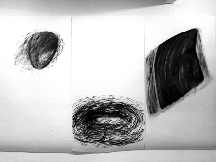- MAIN INDEX | ARTIST INDEX
| March 11 - April 5, 1986 Therese Bolliger
| |
 Therese Bolliger, "Transference", installation detail, 1985-86. Photo Peter MacCallum. 18K | |
|
PRESS Transference is an exhibition of large works on paper by Toronto artist Therese Bolliger. The title of the exhibition not only refers to the term transference in a psychoanalytic context with its meaning of a trauma transferred from patient to analyst, but serves as an analogy to the changing connotations of forms seen within different contexts. It further points to the process of coming to terms with a personal or collective history, a procedure not unlike certain aspects of the art making process. The two works on exhibit deal with the notion of objects, collective and private, as carriers of meaning across time and cultural boundaries. These objects are seen as extensions of human beings, their existence establishing the duality of presence and absence in relation to a human body. Therese Bolliger graduated from the School of Visual Arts in Basle, Switzerland, before coming to Canada. Over the last years she has taught studio courses at the Ontario College of Art, the University of Guelph and Erindale College, University of Toronto. Her work has been shown in solo exhibitions at the Southern Alberta Art Gallery, Lethbridge, Alberta (1984); McIntosh Gallery, University of Western Ontario (1983); and Factory 77, Toronto (1980). Her work has been included in group exhibitions at The Gallery Stratford (1985); Canada House Art Gallery, London, England (1984); and Harbourfront Art Gallery, Toronto (1983)
THERESE BOLLIGER Now Magazine, March 1986 Therese Bolliger has just completed a new work for this exhibit, a compelling piece that satisfies her desire to make images that embody the essence of contradiction. Not for its own sake but to cause second thoughts and reconsideration of all that is around us, of who we are, what we think and why. Bolliger puts images of the unremarkable through their paces: a book, a bow tie, a hill. Bolliger hangs long, wide lengths of sturdy paper from the wall up near the ceiling leaving the bottom to hang with what natural flex is in the paper (from being rolled in packing or transport). And then she works with real stick charcoal, dusty and crackly, that grips the paper for dear life, so unsubstantial until treated with spray fixative. But the work begs to be caressed: the shapes are juicy and spongy, black and dense. "I have made a conscious and deliberate decision to combine the fragile and vulnerable with the strong and aggressive, so that what you are looking at is simultaneously compellingly beautiful and upsetting," says Bollinger. She has a mind of her own and she uses it, making admirable decisions about how she wants things to be. Look at Bolliger's bow tie: it aches to be wider and more pointy at the ends and it just will not straighten out no matter how much you want it to. "I made a bow tie once that everyone thought was beautiful. It was the quintessential bow tie and so of course I couldn't use it. It was beautiful and that was the problem."
| |